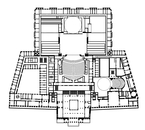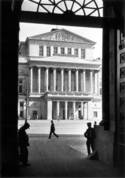Grand Theatre - Polish National Opera
alias Teatr Wielki – Opera Narodowa (Grand Theatre – Polish National Opera, 1993-1996), Opera i Filharmonia (Opera and Philharmonic, 1948-1951), Opera (The Opera, 1951-1962), Scena Muzyczno-Operowa (Music and Opera Stage, 1945-1948), Teatr Narodowy – Scena Operowa (National Theatre – Opera Stage, 1996-1998), Teatr Wielki (Grand Theatre, 1833-1939, 1962-1993)Important events
People
A sculptor and teacher. He studied at the Faculty of Sculpture at the Academy of Fine Arts in Warsaw. Adam Myjak is the author of 50 individual exhibitions and abroad. He has done quadriga sculpture for the Grand Theatre in Warsaw.
Sculptor and teacher. In the years 1964 - 1970 he studied at the Faculty of Sculpture at the Academy of Fine Arts in Warsaw. He has done quadriga sculpture for the Grand Theatre in Warsaw.
In the years 1819-1923 he studied at the Faculty of Fine Arts, University of Warsaw. From 1844 to 1862 he taught sculpture and ornamental drawing at the School of Fine Arts in Warsaw. He made sculptural decoration of the facade of the Grand Theatre in Warsaw.
She studied at the Faculty of Sculpture at the Academy of Fine Arts in Warsaw. In 1959, he held an annual study of numismatics at the Ecole des Hautes Etudes Praqtique. Made by a bronze decorative elements in the staircases at the Grand Theatre in Warsaw.
Graduated from the Faculty of Architecture, Warsaw Technical University. Interior architect, creator of posters, book illustrator. In 1965 he made designs of chandeliers, representative rooms in the main lodge at the Grand Theatre in Warsaw.
History
There is no doubt that the first theatre building in Poland erected from scratch and meeting fully all the requirements of a professional theatre was the building of Teatr Wielki (the Grand Theatre) in Warsaw. The theatre was designed by Antonio Corazzi and was built from 1825 to 1833 on a site created by the demolition of the Marywil buildings almost opposite the main town hall.
Corazzi came to Warsaw after the government of the Polish Kingdom had approached the government of Tuscany in 1818 to send the architect to Poland. Teatr Wielki was not the only work by Corazzi[1] in Poland. He prepared his designs in the style of monumental Neo-Classicism, which later became known as the Neo-Classicist ‘Warsaw School’. Most of his designs were connected with Warsaw, with the best known of them being Wielki Theatre. Corazzi designed about 50 buildings and urban developments, including the building of the Sandomierskie Province Commission in Radom and the layout of Bankowy Square in Warsaw.
In 1825 Corazzi submitted his design for a competition announced by the mayor of the city, Karol Fryderyk Woyda, for the Teatr Wielki project, and it won recognition from Reverend Franciszek Ksawery Drucki-Lubecki.[2] One possible reason for this may be that his project made good use of an existing building, the Dom Pod Kolumnami (The Columned House). In this way a coherent architectural composition was formed, making it possible to create a grand square in front of the theatre building and town hall, bordered to the East and the South by Senatorska Street, connecting the Old Town with the new administrative centre.
The Italian architect’s concept anticipated the building of an imposing building juxtaposed from three masses. The basic body of the structure where the auditorium was located, together with the adjoining stage and backstage, was enclosed on two sides by two two-storey-high wings. The Western wing already existed. This was Piotr Aigner‘s the Columned House (built about 1819). However, the Eastern wing, with a similar exterior appearance, had been designated for a ballroom.
There were similarities between this composed mass of the building and the famous theatre built just a few years earlier on Gendarmenmarkt Square in Berlin (1817–1821), designed by Carl Friedrich Schinkel. While certain parallels can be found in the composition of the masses, which in both examples were towering upwards with the most elevated part corresponding to the auditorium, coming in time to look like an ancient temple, the rooms were arranged differently. Unlike Schinkel, who placed the vestibule on the platform of the concert hall, Corazzi, following the French model, located the vestibule along the longest axis of the building and above the foyer.
The building designed by Corazzi was unquestionably one of the most modern theatre buildings in this part of Europe. Its modernity was demonstrated by both its location in the city and the building‘s structure, as well as by the functionally arranged and built rooms.
Construction work was interrupted by the Polish November Uprising in 1831; although it was continued after the unsuccessful war against the Russian Empire, the principles had changed in the meantime. In 1832, General Józef Rautenstrauch addressed the architect Adam Idźkowski[3] to express his opinion on transforming the building into an Orthodox church. Although the idea was never carried out, the dimensions of the auditorium were changed as a result of a box part situated in front of the stage being removed. In addition, in accordance with the general‘s recommendations, the number of seats was reduced from 1873 to 1248.[4]
During the Second World War the theatre burnt down. Only its blackened remains were left: part of the walls, the vestibule in the frontal projection, the main foyer with the side staircase and part of the lobbies of the lower storeys. In 1951, a competition was announced for the reconstruction of the theatre, first prize being won by Professor Bohdan Pniewski’s team. The architects designed a building that was three times larger than the pre-war one. Construction work was accelerated in 1955, and by 1960 the shell of the building was ready. A gala concert inaugurating the opening of the theatre was held on 19 November 1965, almost three months after Pniewski’s death. The rebuilt Teatr Wielki (about 500 thousand cubic metres in volume) was the largest theatre building in the world and could easily house Milan’s La Scala.
From 1833 to 1924, in the building’s left wing, a dramatic stage was in use, known as Rozmaitości Theatre, and thereafter the National Theatre. Interrupted by fires in 1883, 1919, and 1985, it was reopened in November 1997 after the last reconstruction.
[1] Corazzi designed ca. 50 buildings and urban issues, including the building of the Komisja Województwa Sandomierskiego (Sandomierskie Province Commission) in Radom and the layout of Bankowy Square in Warsaw.
[2] Piotr Biegański, Teatr Wielki, Warszawa 1974, p. 28. Franciszek Ksawery Drucki-Lubecki was a treasury minister of the Polish Kingdom in 1821-1830.
[3] Adam Idźkowski (1798-1879) – a well known Warsaw architect, designer and poet. Accredited constructor of imperial castle and palaces in Warszawa and Skierniewice.
[4] Piotr Biegański, op. cit., p. 85, 89.
Literature:
-
Biegański P., Teatr Wielki w Warszawie, Warszawa: Państwowe Wydawnictwo Naukowe, 1961.
-
Kerner H., Winnicka Bożena, Teatr Wielki w Warszawie: gmach, Warszawa: Teatr Wielki, 1983.
-
Król-Kaczorowska B., Teatr dawnej Polski. Budynki, dekoracje, kostiumy, Państwowy Instytut Wydawniczy, Warszawa 1971.
-
Król-Kaczorowska B., Teatry Warszawy, Warszawa: Państwowy Instytut Wydawniczy, 1986.
-
Mycielski Z., Blaski i cienie [w:] „Ruch muzyczny” 1966, No. 1.
-
Pierwsze dni Teatru Wielkiego. 18 listopada – 11 grudnia 1965 [w:] „Ruch muzyczny” 1966, No. 1.
-
Przemówienie Arnolda Szyfmana na otwarcie Muzeum Teatralnego 19 listopada 1965 [w:] „Ruch muzyczny” 1966, No. 1.
-
Przemówienie Jarosława Iwaszkiewicza wygoszone na uroczystości otwarcia Teatru Wielkiego w Warszawie, 19 listopada 1965 [w:] „Ruch muzyczny” 1966, No. 1.
-
Szczublewski J., Teatr Wielki w Warszawie : 1833-1993, Państwowy Instytut Wydawniczy, Warszawa 1993.
-
Szczublewski J., W gmachu Teatru Wielkiego w Warszawie 1918-1939, Teatr Wielki - Opera Narodowa, Warszawa 2009.
-
Teatry Polskie w trzydziestoleciu 1944-1974. Słownik, Polska Akademia Nauk, Instytut Sztuki, Warszawa 1975.
-
Warszawski Przewodnik Teatralny, Warszawa 1988.
-
Witkiewicz-Koszczyc J., Projekt odbudowy Teatru Wielkiego w Warszawie, „Pamiętnik Teatralny” 1952, No. 2-3.
Author: Bożena Grzegorczyk
Additional information
lm - Fatherland - ojczyzna. Which is sehawmot strange, given that Poland is of female gender in Polish (Polska) and as an archetype it feels more feminine. But then, the idea of fatherland is more about the country of my (fore)fathers . And in this sense it would be (pleasantly) surprizing to have it correspond to the mother, which - as a Polish arche/stereotype has it - is a woman hidden behind the man, sacrificing herself for the country and the family (and God, of course), etc.As for me, I am going home to mommy\'s house for the moment, so it is fatherland and Mother s land, a combination I appreciate.BTW, the idea of fatherland has been intriguing me for a while now and i might start some work on it, so the question is on the spot.
Ahmet - 13.12. 2015
Add information































